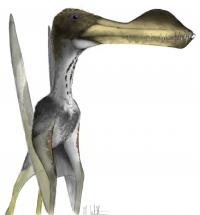
This is an image of a giant pterosaur, Coloborhynchus New research from the Universities of Portsmouth and Leicester has identified a small fossil fragment at the Natural History Museum, London as being part of a giant pterosaur – setting a new upper limit for the size of winged and toothed animals.
Dr David Martill from the University of Portsmouth and Dr David Unwin from the University of Leicester examined the fossil - which consisted of the tip of a pterosaur snout that had been in the Museum collections since 1884.
Their identification of the fossil as being part of the world's largest toothed pterosaur has been published in Cretaceous Research.
Dr Unwin, from the School of Museum Studies at the University of Leicester, said: "Our study showed that the fossil represented a huge individual with a wingspan that might have reached 7 metres. This is far larger than, for example, any modern bird, although some extinct birds may have reached 6 metres in wingspan.
"What this research shows is that some toothed pterosaurs reached truly spectacular sizes and, for now, it allows us to put a likely upper limit on that size – around 7 metres in wingspan."
Dr Martill, from the University of Portsmouth, added: "It's an ugly looking specimen, but with a bit of skill you can work out just exactly what it was. All we have is the tip of the upper jaws - bones called the premaxillae, and a broken tooth preserved in one socket.
"Although the crown of the tooth has broken off, its diameter is 13mm. This is huge for a pterosaur. Once you do the calculations you realise that the scrap in your hand is a very exciting discovery.
"The specimen was placed in the collections of London's Natural History Museum by Sir Richard Owen, perhaps the world's greatest vertebrate palaeontologist. In his day, Owen reconstructed a giant New Zealand Moa from a single bone. We might never achieve Owen's calibre, but it is nice to think that we are following in his footsteps."
Pterosaurs are flying reptiles, famously seen in Jurassic Park, that lived in the Mesozoic Era alongside dinosaurs between 210 and 65 million years ago.
There are six or seven major groups of toothed pterosaurs, but in this study the researchers focused on just one: the ornithocheirids. Unlike other toothed groups, all of which were of relatively modest size (wingspans at most of 2 or 3 metres), they are known to have achieved very large and possibly even giant sizes with wingspans of 6 meters or more. Ornithocheirids were specialised fish-feeding pterosaurs that used a fiercesome set of teeth in the tips of the jaws, to grab their prey as they flew low and slow over the surface of the water.
Dr Unwin said: "We found that, generally speaking, large ornithocheirids reached wingspans of 5 or 6 metres which was consistent with previous ideas about this group. However, we also came across one fossil, collected in the mid-19th century from a deposit in Cambridgeshire called the Cambridge Greensand that seemed to be unusually large.
"This fossil, now in the collections of the Natural History Museum, London, consisted of the tip of a pterosaur snout. The shape of the snout and the broken-off tooth that it contained allowed us to identify the new find as belonging to Coloborhynchus capito, a very rare ornithocheirid represented only by a few fossil fragments from the Cambridge Greensand. Calculating the original size of the animal based on just a fragment is difficult, but we were able to take advantage of some recent finds in Brazil of almost complete skeletons of ornithocheirids that are closely related to the Cambridge Greensand jaw fragment."
"Our study showed that the fossil did indeed represent a very large individual with a wingspan that might have reached 7 metres."
Significantly, though, this is still far short of the giant size achieved by some toothless pterosaurs. Several species of a group called azhdarchids achieved wingspans of around 10 metres.
The challenge for the researchers now is to try to understand why some groups, such as azhdarchids, reached these giant sizes, while toothed forms, such as the ornithocheirids, did not. Teeth are heavy, so part of the explanation may lie in weight reduction by losing these. 
An Ornithocheirus and Coloborhynchus have a 'who can stand the tallest' competition while two Anhanguera look a bit worried. Drawn to show ornithocheirid diversity.
Dr Unwin said: "This research is important because it helps us to better understand patterns of evolution over millions of years, and in groups that are now extinct. At a more general level, it feeds into TV documentaries such as the current series 'Dinosaur Planet' on BBC1, ensuring that they have the 'ring of authenticity' that ensures successful reception, by experts and the lay public alike. Indeed, these programs are enormously popular, as viewing figures show, allowing us to comfort ourselves with the thought that the research we carry out is helping to satisfy the interests of a not insignificant portion of the viewing public.
"For Dave Martill and I, this was to some extent the 'bread and butter' stuff that we do everyday. But it's this slow piling up of data and, critically, its connection into our general understanding, that leads to the really big discoveries. Dave likes to refer to the fossil as the ugliest fossil he ever studied, and I can see his point, but as I did my PhD on Cambridge Greensand pterosaurs they have a special place in my affections and, no matter how ugly, I still love them." Source : University of Leicester
 Print Article
Print Article Mail to a Friend
Mail to a Friend
